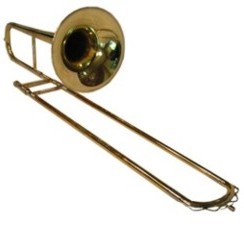I want to add a few thoughts to last months article on the trumpet. Once you’ve gotten through the program outlined last month, and you can play perfect glissandos between intervals and you’ve trained your fingers to do what the slide cream did on your valves, you should be able to visualize a perfect legato. When you play a legato phrase it should appear that the valves never stop moving. As one goes down, another is moving up, and so on. I have often said to trombone players, “even if you stop at each position, imagine that you don’t.” This does amazing things to the continuity of the air stream. Fortunately, with valved instruments, you don’t have to stop at all on a note in a legato phrase. It should be as though the air is changing the notes, and the valves just follow along. After many years of saying I move my air and slide at the same time, I’ve figured out that I actually move my air AHEAD of the slide; you should do the same thing with the valves. The valves should be pulled along smoothly because the air went to another note.
I’ve also found a new way of describing what should happen in a lip slur. The way to a great lip slur is to delay that jump to the next partial as long as possible, so there is some legato sound before the note changes. This will help slow down the actual change and avoid a “wincing” quality to the slur which many people are content with. The more control you have over the air and the speed of the air and the speed of the slur, the more control you have over the slur. Match your lip slurs to your smoothest valve slur and not vice-versa. Then watch your sound change into something special.
The term “portamento” in Mahler symphonies usually signifies a slight glissando in legato passages. But what does the term “molto portamento” mean in an articulated passage? I must say I haven’t heard a performance of Mahler where an articulated passage marked “molto portamento” (such as the solo trumpet part in the 5th movement of the 2nd symphony or the Posthorn solo in the 3rd) was played in anything other than the normal tongued tenuto style. I think he gives us a clue in the trio of the scherzo of the 2nd symphony, where the solo trumpet has hair-pins under each dotted quarter note. When in the 5th movement he writes “molto portamento” in an articulated passage with tenuto marks over each note, I believe a soft, but clear attack, with a hair-pin on each note achieves the desired effect. This is not to be confused with the dreaded “DWA” attack, which is a common virus throughout the world. In the same movement Mahler marks the horns “molto portamento” with marcato hats over each note. These should be played with a hair-pin and a breath accent in the middle of each one. It is noteworthy to remember that hair-pins in Mahler (there are hundreds in the 2nd symphony) are usually not heard the way the composer intended. They need to be exaggerated to produce the desired effect. Trombone players should refer to my analysis of the solo from the 3rd symphony for an example of portamento in an articulated form. The legato passages in Mahler (and Wagner for that matter) virtually cry out for the kind of legato-portamento described in last month’s column. Mahler didn’t write those legato obligato’s, with their long interval jumps up and down, to sound hard and clean the way we generally hear today. Just as important is not mixing articulated notes and legato into one even, boring, generic articulation. Composers took great pains to carefully specify slurred and tongued passages. We should try to bring out the differences as much as possible to expand the stylistic language that our instruments are capable of.

I have a report on the Kruspe trombone that I described in a previous column. The Thein brothers have duplicated this horn (see pictures below). It is the most beautiful trombone I’ve ever seen. It is an exact copy of the old horn which dates from before WW1. It has a brass slide and no tuning slide or spit valve, as was the old custom. This horn should be in a museum. The idea is to make an exact copy and then add modern features without changing the old classic sound. It has amazing response and an almost perfect overtone series. It is the size of our modern instruments, and miraculously takes a modern large shank mouthpiece. It will be on display at the ITF in Ithaca, from June 17-19. I may also demonstrate it in my clinic on Friday morning, June 18th.
This brings me to a related topic. I think the ITA should embark on a project to collect and display the best of the greatest instruments ever built. These instruments are our Strads and we need to preserve them for future generations. Trombones are very perishable, especially if they play well, and there needs to be a central repository for the greatest examples of our art.